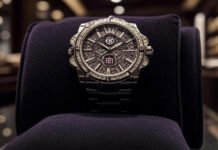In the world of luxury timepieces, Hublot has long been synonymous with innovation, craftsmanship, and exclusivity. Known for its bold designs and the “Art of Fusion” philosophy, the Swiss watchmaker has carved out a distinct niche in the horology industry. However, alongside the brand’s rise to prominence, a parallel market for Hublot Replica watches has flourished, drawing attention from consumers, industry experts, and regulators alike. As demand for affordable luxury alternatives grows, recent developments have brought the replica watch market under increased scrutiny, raising questions about quality, ethics, and the future of accessible luxury.
The Appeal of Hublot Replicas
Hublot’s signature collections, such as the Big Bang and Classic Fusion, are celebrated for their avant-garde aesthetics and use of high-tech materials like ceramic, sapphire crystal, and proprietary “Magic Gold.” However, with authentic Hublot watches often retailing for tens of thousands of dollars, they remain out of reach for many enthusiasts. This price barrier has fueled the popularity of replica watches, which aim to emulate the design and functionality of genuine Hublot timepieces at a fraction of the cost.
High-quality replicas, often crafted with materials like stainless steel and equipped with Swiss-made movements, have become increasingly sophisticated. Some models, such as those mimicking the iconic Big Bang chronograph, are designed to closely resemble their authentic counterparts, complete with detailed dials and robust cases. These replicas cater to a diverse audience, from watch collectors seeking affordable additions to their collections to fashion-conscious individuals looking to project an image of success without breaking the bank.
Recent reports indicate a surge in online sales of these replicas, with e-commerce platforms and specialty retailers like PyLuxury and United Luxury Shop offering extensive catalogs. These sites emphasize the craftsmanship of their products, often highlighting features like water resistance and precise timekeeping to attract discerning buyers. Yet, this growing market has not gone unnoticed by authorities and luxury brands, prompting a wave of regulatory and legal actions.
Regulatory Crackdowns and Ethical Concerns
In early 2025, several high-profile raids on counterfeit goods operations in Europe and Asia targeted distributors of replica luxury watches, including those branded as Hublot. Authorities seized thousands of imitation timepieces, citing trademark infringement and consumer deception. These crackdowns reflect a broader effort by luxury watchmakers and international trade organizations to curb the proliferation of counterfeit goods, which they argue undermine brand integrity and market trust.
Hublot, like other Swiss watchmakers, has been vocal about protecting its intellectual property. The company invests heavily in research and development, creating innovations like scratch-resistant gold and vibrant ceramic hues. Replicas, even high-quality ones, often bypass these proprietary technologies, leading to debates about their legitimacy. Critics of the replica market argue that purchasing knockoffs supports unethical practices, including potential links to organized crime and substandard working conditions in manufacturing hubs.
However, some consumers view replicas as a democratizing force in the luxury goods sector. For those unable to afford a $20,000 Big Bang Unico, a well-crafted replica offers a taste of luxury without the financial strain. This perspective has sparked discussions about accessibility in the luxury market, with some analysts suggesting that brands like Hublot could explore more affordable product lines to capture this demand.
Quality and Craftsmanship: How Close Are Replicas?
One of the most intriguing aspects of the Hublot Replica market is the level of craftsmanship in high-end models. Unlike low-quality fakes, which are easily spotted due to poor materials or inaccurate designs, top-tier replicas are designed to be nearly indistinguishable from the originals. Retailers like ReplicaMagic and JF Factory boast of using premium materials and Swiss movements, ensuring that their products not only look the part but also perform reliably.
For example, replicas of the Hublot Big Bang Unico Blue Sapphire Flyback (model 411.JL.4809.RT) feature cases made from high-grade stainless steel or ceramic, with sapphire crystal faces that mimic the originals’ durability. Some even include functional chronographs and accurate weight distribution to replicate the feel of a genuine Hublot. However, experts note that replicas often fall short in areas like long-term durability and the intricate finishing that defines Swiss watchmaking excellence.
Watch enthusiasts have mixed opinions on these replicas. On forums and social media platforms like X, collectors share tips on spotting fakes, pointing to details like incorrect logo placements or subpar engravings. Yet, others praise the accessibility of replicas, arguing that they allow more people to appreciate Hublot’s bold designs without the prohibitive cost.
The Role of E-Commerce and Consumer Awareness
The rise of e-commerce has been a double-edged sword for the replica watch industry. Online platforms have made it easier for consumers to access a wide range of replica Hublot watches, from the sporty Big Bang to the elegant Classic Fusion. Websites like swissreplica.is and replicachronoshop.com offer detailed product descriptions, customer reviews, and even guides on choosing the right replica, fostering a sense of transparency that appeals to buyers.
However, this accessibility has also led to an influx of low-quality fakes, which can mislead unsuspecting consumers. Industry experts recommend purchasing from reputable dealers who prioritize quality and offer clear return policies. They also advise buyers to research the telltale signs of a fake, such as inconsistent font sizes or misaligned bezels, to avoid disappointment.
Consumer awareness is further complicated by the marketing tactics of some replica retailers. Phrases like “1:1 clones” and “Swiss-made movements” can create a false sense of authenticity, blurring the line between replica and counterfeit. To address this, regulatory bodies are pushing for stricter guidelines on how replicas are marketed, emphasizing the need for clear disclaimers to distinguish them from genuine products.
The Future of the Replica Market
As the luxury watch market continues to evolve, the replica industry faces both challenges and opportunities. On one hand, advancements in manufacturing technology are enabling replica makers to produce increasingly convincing imitations, potentially capturing a larger share of the market. On the other hand, luxury brands like Hublot are doubling down on innovation and exclusivity, introducing limited-edition pieces like the Big Bang Unico Ice Bang, which are harder to replicate due to their unique materials and craftsmanship.
Recent collaborations, such as Hublot’s partnership with artist Daniel Arsham on the Arsham Droplet pocket watch, highlight the brand’s commitment to pushing boundaries. These high-profile releases not only reinforce Hublot’s prestige but also make it more difficult for replica makers to keep pace with the brand’s rapid innovation cycle.
Looking ahead, the replica market is likely to remain a contentious issue in the luxury goods sector. While some consumers will continue to seek affordable alternatives, others argue that the true value of a Hublot lies in its craftsmanship, heritage, and exclusivity—qualities that replicas, no matter how well-made, cannot fully replicate. As regulatory scrutiny intensifies, the industry may see a shift toward greater transparency and accountability, potentially reshaping how replicas are produced and sold.
Conclusion
The Hublot replica market is a complex and multifaceted phenomenon, reflecting broader trends in consumer behavior, luxury accessibility, and regulatory challenges. While replicas offer an affordable entry point into the world of high-end timepieces, they also raise important questions about ethics, quality, and brand integrity. As Hublot continues to innovate and captivate watch enthusiasts, the replica market will likely evolve in tandem, navigating a delicate balance between affordability and authenticity. For now, consumers are advised to approach the replica market with caution, prioritizing reputable sellers and staying informed about the nuances of luxury watchmaking.










